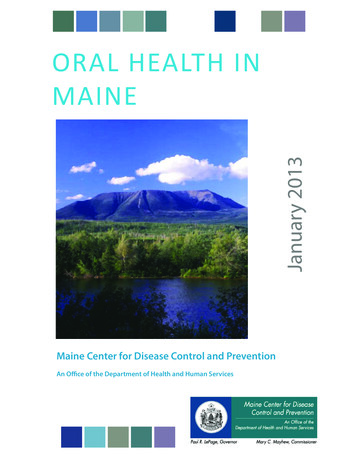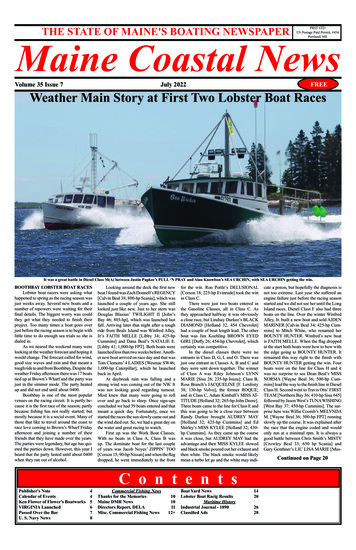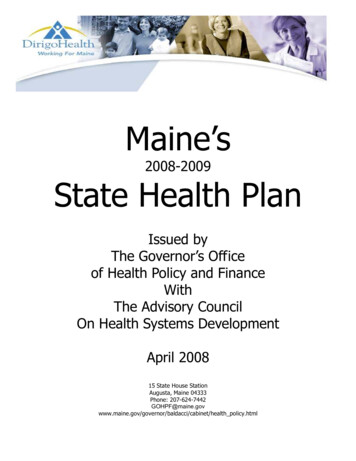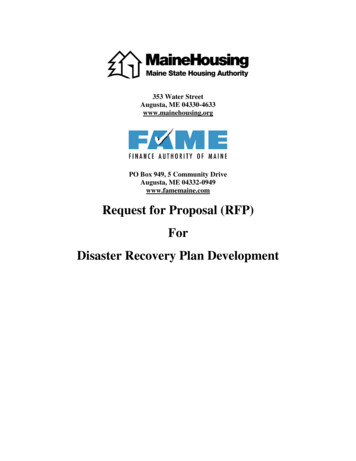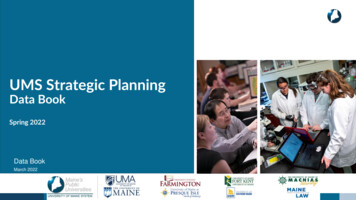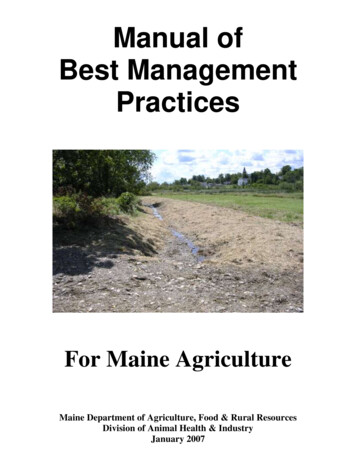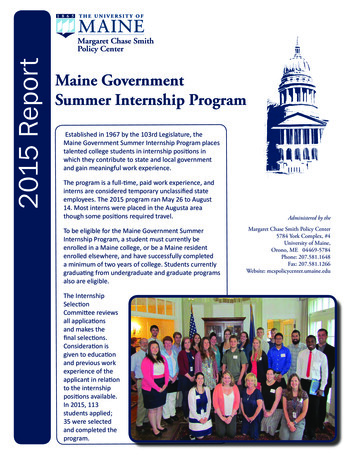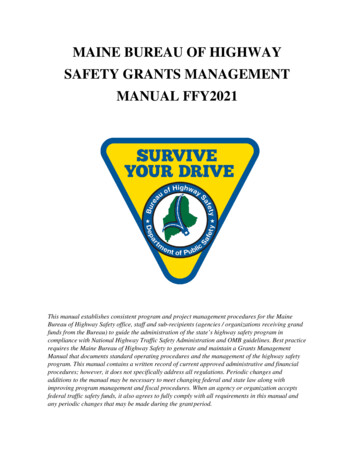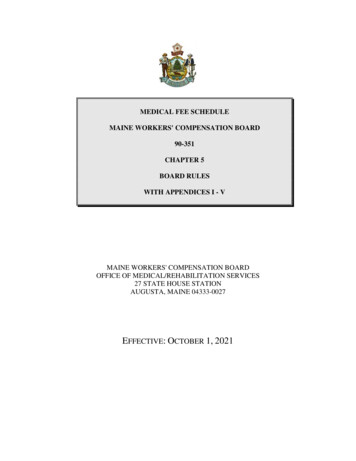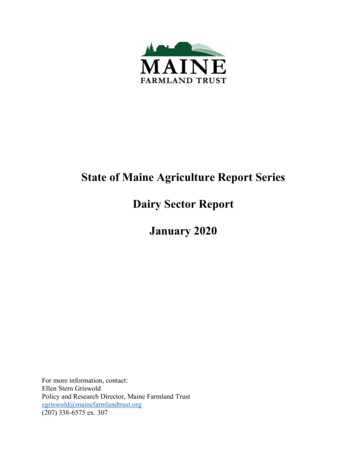
Transcription
State of Maine Agriculture Report SeriesDairy Sector ReportJanuary 2020For more information, contact:Ellen Stern GriswoldPolicy and Research Director, Maine Farmland Trustegriswold@mainefarmlandtrust.org(207) 338-6575 ex. 307
State of Maine Agriculture Report SeriesDairy Sector Report 1I.Executive SummaryThroughout its history, the dairy sector has been a consistent agricultural and economic forcein Maine. The farms that make up Maine’s “dairy belt” 2 have acted as hubs of stability andcommerce for generations. These farms have served as crucial rural economic developmentengines, and have provided the necessary threshold of business for veterinarians, feed andmachinery suppliers, and truckers tocomfortably set up shops in towns like China,Clinton, Monmouth, Detroit, and manyothers. 3Despite its rich history, recently Maine'sdairy sector has reached a crisis point. 4Farmers are facing daunting challenges thatthreaten the stability of the sector. As dairyfarmer Spencer Aitel, owner of the organicTwo Loons Farm in South China, explains,many dairy farms are only surviving becauseMaine Farmland Trust wishes to thank William Sedlack, Andrew Marshall, and Ashleigh Angel for their extensiveresearch and writing contributions to this report.2Email from Julie-Marie Bickford, Executive Director, Maine Dairy Industry Association, to William Sedlack,Research and Policy Intern, Maine Farmland Trust (Apr. 19, 2018) (On file with author) (explaining that the “dairybelt” of Maine traditionally runs from eastern/northern Androscoggin County, through eastern Franklin County, overto Kennebec County and Southern Somerset County, Southern Piscataquis and Penobscot counties, over to WaldoCounty).3Id.4Interview with Spencer Aitel, Owner, Two Loons Farm, South China, ME (Mar. 6, 2018).11
of “the will of the family.” 5 This crisis point, which is happening in many areas of the country,has resulted in farmersgoing out-of-businessand even concerns aboutsuicide. 6 It, coupled withchanging demographictrends, has also led to asignificant reduction inthe number of dairy farms in Maine, declining from 4,578 total dairy farms in 1954 to 286 by2017. 7This report provides a historical perspective and contemporary analysis of these challenges.It also presents some opportunities for policy and market interventions that could help tostabilize the Maine dairy sector and enhance its future viability.ChallengesRising costs of production and low pay prices: The cost of producing milk in Maine hasrisen steadily over the past 50 years, while the price that farmers receive for their milk has5Id.Lauren Abbate, Organic Dairy Farmers ‘Weathering the Storm’ as Milk Prices Drop, Production Quotas Set,Bangor Daily News (Sept. 23, 2017), rices-drop-production-quotas-set/.; Lisa Rathke, Suicides Prompt Outreach toNortheast Dairy Farmers, Portland Press Herald (Mar. 3, 2018) mpt-outreach-to-northeast-dairy-farmers/.7United States Department of Agriculture (USDA), National Agricultural Statistics Service (NASS), Census ofAgriculture for 1954, /getVolumeOnePart.do?year 1954&part id 506&number 1&title Maine [hereinafter 1954 Census] (last visited Oct. 16, 2018).; USDA, NASS, Census of Agriculture for AgCensus/2017/Full Report/Volume 1, Chapter 1 State Level/Maine/[hereinafter 2017 Census] (last visited May, 2019).62
become increasingly volatile. This often means that the cost of production is higher thanrevenues, as has been the case for the past 5 years.An aging dairy farmer population and uncertain succession options: A plurality of Maine'sdairy farmers are nearing retirement, and it is unclear how many of them have identifiedsuccessors. As land values climb and development pressure mounts, many farmers are facing adifficult choice about the future of their operations and the land base that supports them.Demographic shifts have reduced the number of farms and amount of farmland inMaine's dairy sector: The number of farms and amount of farmland in the dairy sector in Mainehave diminished significantly since the mid-1950s. Although increases in efficiency havesupported production levels during this period, the pace of this reduction has accelerated in thepast decade.OpportunitiesContinue to support and invest in Maine’s Dairy Stabilization Program: Maine is uniqueamong Northeast states in that it has committed to supporting dairy farmers with cash paymentsthrough its Dairy Stabilization Program, or the Tier Program, when milk prices fall below thecost of production. This support has had a demonstrable and important effect on Maine dairyviability, according to the data and the experts we interviewed. Continued political support forthe funding of this program is crucial to protecting the dairy sector during this prolonged marketcontraction.Explore the potential for expanded processing capability in Central Maine: Expandingdairy processing capacity, particularly for value-added products and closer to where milk isproduced in Maine, could help dairy producers grow their businesses and appreciably lower3
production and transportation costs for the dairy sector, thus affording producers and processorsmore control over the production and marketing process.Explore the development of regional pricing: Presently, the price of milk in Maine isdetermined by a complex formula based on variables that poorly reflect the realities of dairyfarming in Maine. A regional pricing system, using variables that are more sensitive to regionalproduction costs and market signals, could provide Maine producers with a more stable andpredictable environment for future business planning, and serve as an effective tool for achievingregional dairy viability. Maine could play a strong role in helping to shape these regional andnational discussions.II.BackgroundMaine Farmland Trust (MFT) is a member-powered statewide organization that works toprotect farmland, support farmers, and advance the future of farming. Since 1999, MFT hashelped to permanently protect nearly 300 farms and keep over 60,000 acres of farmland infarming, while supporting over 800 farm families with a range of services. As part of its State ofMaine Agriculture Report Series, MFT will periodically release reports on different agriculturalsectors in Maine that provide in-depth coverage and analysis of sector-based agricultural trendsfor policymakers and others working on these issues. The purpose of the Series is to provideinformation about these trends to those working on agriculture policy in Maine so that targetedpolicies are advanced that address the needs of each agricultural sector. The authors havefocused on the dairy sector as the first of these reports because of its prominence within Maineagriculture and its current economic state.This report will look at several of the important trends for the dairy sector in Maine in orderto inform stakeholders and policymakers both of the dairy sector’s current landscape and its4
historical footing. Specifically, the report will examine issues around land, pricing, productioncosts, demographics, and the rise of organic dairy in order to better understand the history ofMaine’s dairy sector, the industry’s future, and the support needed for it to remain an anchor foragricultural communities across Maine.III.MethodologyThis report draws on a number of sources and methods for its analysis and conclusions. Theprimary source for both historical data and recent trends in the dairy sector – including thenumber of farms, land in farms, economic and demographic data, and their trends over time – isthe Census of Agriculture, administered every five years by the United States Department ofAgriculture National Agricultural Statistics Service (USDA NASS). The most recent Census datawas collected in 2017 and released in April of 2019. In addition, the authors used annual sectorsurveys by NASS, which track milk production, sales, and price information, as well as NASSsurveys of organic production in Maine. Other secondary analyses – such as the annual dairysummary from Farm Credit East, which is a comprehensive analysis of dairy farm financialhealth and profitability; cost of production studies undertaken by the University of MaineCooperative Extension; and annual reports from dairy trade groups – were also valuable sourcesof information.In addition to these sources, the authors undertook interviews with several “dairy sectorexperts,” including dairy farmers themselves, agricultural service providers, and commoditygroup representatives. These first-person perspectives and insights serve to illustrate andreinforce the data sources, and provide a rich complement to the numbers. These experts arequoted throughout the report. A more detailed description of the methodology used for thisreport is included as an appendix.5
IV.FindingsThe Maine dairy sector is in the midst of a challenging period. Farmers are facing low payprices, cost increases, increased development pressure, and demographic shifts that threaten thestability of the industry. This report will address these issues and provide a historical perspectiveand contemporary analysis of these challenges.A. Pricing & Sales IssuesFor conventional dairy farmers in Maine and elsewhere, the price volatility of fluid milk hasbeen one of the biggest barriers to success. The price of fluid milk is currently determined byglobal market forces. 8The price that a dairyfarmer receives for milkis determined by theUSDA through theFederal Milk MarketingOrder. 9 Milk is classifiedby its end use and eachclass of milk is assigned a different price using complex, regionally variable formulas establishedby the USDA. 10 However, export markets, domestic demand, and supply all strongly influencemilk prices. 11Farm Credit East, 2017 Northeast Dairy Farm Summary, 7 (May ee Department of Agriculture, Conservation and Forestry, Maine Milk Commission, How Prices areEstablished, ed.shtml (last visited May 30, 2018).10Id.11Farm Credit East, 2017 Northeast Dairy Farm Summary, 7 (May hange/Reports/2017-northeast-dairy-farm-summary.86
From 1980 to 2006, the average milk price remained stable at around 14.00 per cwt with theexception of a few years. 12 However, since that time, milk pay prices in Maine, and throughoutthe U.S., have been characterized by cyclical boom and bust periods. 13 Milk prices begin thecycle at a low point, progress to significantly high prices, and then drop again to new lowlevels. 14 In recent years, though, the price of milk has become increasingly erratic, remaininglow for an extended period of time rather than the normal 2-3 year cycle. 15 This price volatility isproblematic for dairy farmers who need stable milk prices to inform their business decisions. Asexplained by Rick Kersbergen, Extension Professor of Sustainable Dairy and Forage Systems atthe University of Maine Cooperative Extension:[f]arms have to find a way to manage through [boom and bust] cyclesand that’s where some of that business management skill comes in.And part of the problem, especially in conventional markets, [is that]it’s hard to predict what the milk prices are going to be. So, you reallydon’t have a good way of planning. When do you decide to invest incertain things? When do you decide to go to an expansion or not? It’sall based on a predicted milk price that is out of their control. 16In addition to the price volatility that characterizes the recent dairy market, fluid milk saleshave also seen a gradual but significant decline over time. Between 2008 and 2009, for example,total Maine fluid milk sales decreased by 36,170,000, between 2011 and 2012 by 9,414,000,and between 2014 and 2015 by 40,280,000. 17 This trend reflects the steady decline in fluid milkUSDA, NASS, Annual Survey Data, Maine, Milk Price Received – Measured in F7DE-27E4-334E-BF32-CD5C06CDCD3B (last visited Oct. 18,2018).13Richard Kersbergen et al., Cost of Producing Milk in Maine: Results from the 2010 Dairy Cost-of-ProductionSurvey, University of Maine, 1 (Jan. 2013), ts/b853.pdf.14Id.15Email from Rick Kersbergen, Extension Professor, University of Maine Cooperative Extension, to Ellen SternGriswold, Policy and Research Director, Maine Farmland Trust (Oct. 1, 2019) (On file with author).16Interview with Rick Kersbergen, Extension Professor, University of Maine Cooperative Extension, Freeport, ME(Feb. 22, 2018).17USDA, NASS, Annual Survey Data, Milk Sales – Measured in -F3EE-3E16-A34C-338F009FFFC8 (last visited Oct. 10, 2018).127
consumption that has resulted from the competition with other beverages. 18B. Production Costs & Farm ValueOf all the trends affecting the dairy economy in Maine, rising production costs are causingthe greatest concern for farmers and agricultural stakeholders. Despite some countervailingpositive metrics, costs of production are quickly making dairy an impracticable economic choicefor many farmers. In 1969, 19 total dairy farm production expenses in Maine adjusted forinflation 20 were valued at 11,175,341. By 2017, that number after adjusting for inflation hadgrown to 284,025,446 – an increase of over 2500%. 21 Similarly, the production expenses of anaverage Maine dairy farm increased from 8,122 in 1969 to 993,094 by 2017 after accountingfor inflation. 22 There are a number of reasons for the remarkable increase in production expensesfor Maine’s dairy farms. The primary drivers have been increasing input costs such as labor, fueland grain, and the role that economies of scale play in cost of production relative to profitability.In comparison to other dairy farms in the Northeast, Maine dairy farms also have higheroperating expenses. 23 In particular, the 2010 Maine Milk Commission cost of production survey18Email from Julie-Marie Bickford, Executive Director, Maine Dairy Industry Association, to Ellen Stern Griswold,Policy and Research Director, Maine Farmland Trust (Oct. 23, 2019) (On file with author).19The Census of Agriculture does not include total or average farm production expenses for classified dairy farmsbefore 1969.20See Appendix: Methodology for a description of how the data has been adjusted to reflect inflation.21USDA, NASS, Census of Agriculture for 1969, /getVolumeOnePart.do?year 1969&part id 275&number 1&title Maine [hereinafter 1969 Census] (adjusted for inflation using the Consumer Price Index) (last visited Oct. 18,2018); 2017 Census (adjusted for inflation using the Consumer Price Index).221969 Census (adjusted for inflation using the Consumer Price Index); 2017 Census (adjusted for inflation usingthe Consumer Price Index).23Xuan Chen et al., Cost of Producing Milk in Maine: Results from the 2013 Cost-of-Production Survey, Universityof Maine, 7 (May /viewcontent.cgi?article 1083&context aes bulletin.8
found that Maine dairyfarms had higher laborcosts and lower laborefficiency. 24 Accordingto Rick Kersbergen, thishigher level of costresults from a loweraverage number ofcows per worker on Maine dairy farms, which is attributable to many factors but especially to anaging infrastructure and the lack of investment in new facilities and technology. 25 In addition, theMaine Milk Commission report, Determining the Current Cost of Producing Milk in Maine2016, found that “purchased grain cost is one of the highest expense categories on a dairyfarm.” 26 This is especially problematic for dairy farmers in New England because the regiondoes not produce the majority of its grain. 27 Maine also sits at the end of the delivery line,making many imported inputs comparatively expensive for dairy farmers. 28 Moreover, theunpredictable cost of fuel, and the role that fuel plays in many levels of production, makesfinancial planning difficult. 29Richard Kersbergen et al., Cost of Producing Milk in Maine: Results from the 2010 Dairy Cost-of-ProductionSurvey, University of Maine, 6 (Jan. 2013), ts/b853.pdf.25Email from Rick Kersbergen, Extension Professor, University of Maine Cooperative Extension, to Ellen SternGriswold, Policy and Research Director, Maine Farmland Trust (Oct. 1, 2019) (On file with author).26Dr. Gary Anderson et al., Determining the Current Cost of Producing Milk in Maine 2016, 6 (March uments/MMC FinalReport 3 23 18.pdf.27Interview with Rick Kersbergen, Extension Professor, University of Maine Cooperative Extension, Freeport, ME(Feb. 22, 2018); Farm Credit East, 2017 Northeast Dairy Farm Summary, 10 (May Interview with Rick Kersbergen, Extension Professor, University of Maine Cooperative Extension, Freeport, ME(Feb. 22, 2018).29Id.249
Economies of scale have a significant influence on dairy farm profitability as well.According to Rick Kersbergen, this is because “[i]ncreasing size allows you to spread outinfrastructure and equipment costs over more cows. [Increasing size] [a]lso allows for thepurchase of more efficient machinery (tractors, harvest machinery, milking equipment such asparlors etc.).” 30Kersbergen notesthat “it’s a toughsituation whereyou go from asmall farm tolarge farm andyou’re in thatintermediate stage.” 31 But if Maine dairy producers could produce more of their own feedstockat a competitive price, that could reduce some of the production cost burden. 32C. Land & Farm SizeAlthough dairy has been a dominant agricultural land use in Maine since World War II, thenumber of acres held by dairy farms has decreased precipitously since 1954. In 1954, farmscategorized as dairy farms in Maine (“classified dairy farms”) held 1,009,603 acres of land. 33 By2017, that number had fallen to 145,490 acres – a net decrease of 85%. 34 Some of this declinehas resulted from advances in technology and methodology that have allowed farmers to produce30Id.Id.32Id.331954 Census.342017 Census.3110
more on existing land – allowing them to give up less productive acreage. 35 But, developmentpressure, especially in Southern Maine, has also contributed to the acreage decline. Farmers inSouthern Maine’s dairy belt are often competing against housing developers as they look toexpand herds and obtain new grazing land. This development pressure, which is an increasingconcern for farmers in central and northern dairy communities as well, forces farmers to confrontthe near-impossible decision of whether to sell their land for profit to developers – at values thatare often many times what the land is worth as farmland – or keep their land in production,sometimes at a net operating loss. Rick Kersbergen explains that development pressure andrising land values are particularly acute for farmers because almost all farms look at their landbase as part of their retirement. “[T]hey don't have retirement income.they don't have anannuity somewhere. They have their farm and their land; and that’s what they’re looking at [asa way to fund retirement].” 36As developer interest in dairy farmland has increased, the value of this farmland hasincreased apace. In fact, there has been a market value increase observed every Census yearduring the 1954 to 2017 period. In 1954, the average land value of an individual dairy farm inMaine was 2,804 (adjusted for inflation). 37 By 2017, that number adjusted for inflation hadincreased nearly one-hundredfold to 2,673,222. 38 The average per acre market value of dairyfarmland and buildings, after accounting for inflation, has also increased four-hundredfold from 12.80 per acre in 1954 to 5,255 per acre in 2017. 39 To Kersbergen, this has meant that as landvalues increase, retirement becomes more appealing to farmers, especially those facingEmail from Julie-Marie Bickford, Executive Director, Maine Dairy Industry Association, to Ellen Stern Griswold,Policy and Research Director, Maine Farmland Trust (Oct. 23, 2019) (On file with author).36Interview with Rick Kersbergen, Extension Professor, University of Maine Cooperative Extension, Freeport, ME(Feb. 22, 2018).371954 Census (adjusted for inflation using the Consumer Price Index).382017 Census (adjusted for inflation using the Consumer Price Index).391954 Census.; 2017 Census (adjusted for inflation using the Consumer Price Index).3511
development pressure. 40 This drastic increase in land value also makes it increasingly difficultfor other farmers, in particular new and beginning farmers, to purchase land unless it is assessedat its agricultural value.As overall dairy farm acreage has declined in Maine, existing acreage has been consolidatedinto increasingly larger farms. In other words, smaller dairy farms have declined moresignificantly and at a faster rate than larger farms. The overall reduction in dairy farms was mostsignificant for farms with milk cow herds of 1 to 9 cows (from 1,043 farms in 1954 to 31 in2017), farms with milk cow herds of 10 to 49 cows (from 3,408 farms in 1954 to 110 in 2017),and farms with cow herds of 50 to 99 cows (from 153 farms in 1959 41 to 66 in 2017). 42 In fact, in1954 dairy farms with herds of fewer than 50 cows comprised almost 98 percent of all dairyfarms, but by 2017 that percentage had dropped to less than 49 percent. 43According to Rick Kersbergen, this is a result of farmers searching for economies of scalethat can only be achieved by expanding their herds and acreages. 44 Owing to a combination ofgenetics and technology, farms have become considerably more efficient over the past sevendecades, as evidenced by the increase in average milk per cow from 6,000 pounds in 1954 to21,000 pounds in 2017. 45 According to Kersbergen, these increases have allowed for the overallamount of fluid milk produced in the state to remain fairly constant at about 600 to 630 million40Interview with Rick Kersbergen, Extension Professor, University of Maine Cooperative Extension, Freeport, ME(Feb. 22, 2018).41USDA, NASS, Census of Agriculture for 1959, sImages/1959/01/01/1959-01-01.pdf [hereinafter 1959 Census] (lastvisited Oct. 18, 2018). Because the 1954 Census of Agriculture only includes a herd category of 50 or more milkcows, data from the 1959 Agriculture Census was chosen to compare the number of farms with milk cow herds of50-99.421954 Census.; 2017 Census.431954 Census.; 2017 Census.44Interview with Rick Kersbergen, Extension Professor, University of Maine Cooperative Extension, Freeport, ME(Feb. 22, 2018).45USDA, NASS, Annual Survey Data, Maine, Milk Production Measured in ts/B5203D0F-B3B3-339A-8052-171363E2BE6E.12
pounds of milk per year despite the reductions in farms in certain size categories. 46 Kersbergenalso notes that “[the] farms that have gone bigger using hired labor [are] trying to increase thenumber of animals that are being served by the same or similar infrastructure so they're justspreading out their capital costs over more animals.” 47 And in fact, the average number of milkcows per farm has grown steadily over this period from 17 milk cows in 1954 to 107 in 2017. 48The shift to larger farms is also reflected in changes to the average size of a classified dairy farm,which has increased from 220.5 acres in 1954 to 509 acres in 2017. 49Julie-Marie Bickford, Executive Director of the Maine Dairy Industry Association,believes that the loss of smaller farms is also the result of shifting societal trends where multiplegenerations of a farming family work on the same piece of land instead of the youngergenerations leaving to start their own farms. 50 To Jenni Tilton-Flood, a dairy farmer fromEmail from Rick Kersbergen, Extension Professor, University of Maine Cooperative Extension, to Ellen SternGriswold, Policy and Research Director, Maine Farmland Trust (Oct. 1, 2019) (On file with author).47Interview with Rick Kersbergen, Extension Professor, University of Maine Cooperative Extension, Freeport, ME(Feb. 22, 2018).481954 Census.; 2017 Census.491954 Census.; 2017 Census.50Email from Julie-Marie Bickford, Executive Director, Maine Dairy Industry Association, to Ellen Stern Griswold,Policy and Research Director, Maine Farmland Trust (Oct. 23, 2019) (On file with author).4613
Clinton, the shift to larger farms is a result of small and mid-size farms deciding to specialize indairy. 51 As they specialized, these farmers moved from the traditional methods of theirgrandparents to more modern techniques. 52 For Tilton-Flood, this means that there “[wasn’t] aloss of agricultural production at that size, but a shifting to production at a different size.” 53Moreover, Jenni Tilton-Flood believes there is a move to larger farms because medium-sizefarms are often “the ones that struggle to see profit. Their profit is generally a little bit lower thana smaller or larger sized farm . . . And a lot of it has to do with their costs. Their costs aredifferent than when they were small and they’re not able to take advantage of economies of scale[like larger farms].” 54 But given the market volatility discussed above, it is far from clear thatthese new trends around economies of scale are enough to sustain dairy farms into the future.D. Demographic Challenges and OpportunitiesThere exist both positive and challenging demographic trends in the Maine dairy industry.Several positive trends in the industry include the growth of female operators and a slightlylower average age for primary operators. In 1978, 55 there were 43 dairy farm operators in Mainethat identified as women, 56 but by 2012 that number had risen to 184. 57 The 2017 Census ofAgriculture began using a modified metric to identify “principal producers,” which uncovered aInterview with Jenni Tilton-Flood, Dairy Farmer, Clinton, ME (Mar. 1, 2018).Id.53Id.54Id.55The number of female classified dairy operators was not provided before the 1978 Census of Agriculture.56USDA, NASS, Census of Agriculture for 1978, /getVolumeOnePart.do?year 1978&part id 153&number 19&title Maine [hereinafter 1978 Census] (last visited Oct. 22, 2018).57USDA, NASS, Census of Agriculture for 2012, sus/2012/Full Report/Volume 1, Chapter 1 State Level/Maine/[hereinafter 2012 Census] (last visited Oct. 18, 2018).515214
significant undercounting of women farmers across sectors in past Census reports. As a result, by2017, the number of female dairy producers stood at 221. 58Sarah Littlefield, formerly the Dairy Program Director at Wolfe’s Neck Center forAgriculture and the Environment and now Executive Director of the Maine Dairy PromotionBoard, has noticed the shift: “nationally, there is a growing trend of women in the forefront ofthe dairy industry, and certainly here at Wolfe's Neck we’ve seen more female Apprentices cometo the program than we have male.” 59 To Jenni Tilton-Flood, the numbers have deeper meaning.She noted that women have always been running the dairy farms, but they may not have beenfilling out the paperwork. For Tilton-Flood, the increase in the number of primary operatorsidentifying as women indicates “that women are now saying, ‘yes, I am part of this farm.’” 60This observation appears to be borne out by the 2017 Census.Maine dairy farmers are also slightly younger than their counterparts in other farmingsectors. In 2017, the average age ofall farmers in Maine was 56.5,whereas the average age of aprincipal producer of a dairyfarmer was 53.2. 61 In fact, theaverage age of Maine dairy farmershas been declining slightly since its582017 Census.Interview with Sarah Littlefield, former Dairy Program Director, Wolfe’s Neck Center for Agriculture and theEnivronment, Freeport, ME (Feb. 20, 2018).60Interview with Jenni Tilton-Flood, Dairy Farmer, Clinton, ME (Mar. 1, 2018).612017 Census.5915
peak at 55 in 2007. 62 Despite this small decline in the Census data, many of the expertsinterviewed are concerned that the average age of dairy farmers is increasing in reality, and somefarmers such as Spencer Aitel are still concerned about who will inherit their business. 63According to Kersbergen, entering the dairy sector is particularly challenging because of the“large amount of capital it takes to become a dairy farmer.” 64 Overcoming those challenges willbe critical to getting more farmers to enter the dairy sector. 65 For David Herring, ExecutiveDirector of Wolfe’s Neck Center for Agriculture and the Environment, confronting these barriersto entry has become an organizational mission, because “when you get new people in anindustry, whether they’re in their twenties or thirties you’ll have them looking to makeimprovements to facilities that can serve them for the next twenty and thirty years becausethey’re at the beginning of their careers.” 66E. Organic DairyDuring the past twenty turbulent years in Maine's conventional dairy sector, transition toorganic had been an option for dairy farmers seeking stable prices and market predictability ifthey were willing to change their production practices. However, in light of a recent butprolonged slowdown in the growth of demand for organic dairy, some are concerned that eramight be over. According to Spencer Aitel, “the strength of the organic market has been it
the number of dairy farms in Maine, declining from 4,578 total dairy farms in 1954 to 286 by 2017.7 This report provides a historical perspective and contemporary analysis of these challenges. It also presents some opportunities for policy and market interventions that could help to stabilize the Maine dairy sector and enhance its future viability.
